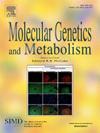Using multiple modalities to confirm diagnosis in patients with suspected peroxisome biogenesis disorders
IF 3.7
2区 生物学
Q2 ENDOCRINOLOGY & METABOLISM
引用次数: 0
Abstract
Zellweger spectrum disorder (ZSD) results from biallelic variants in any one of 13 PEX genes involved in peroxisome biogenesis and function. The majority of ZSD cases result from pathogenic variants in PEX1. Here, we present 3 patients with suspected PEX1-related ZSD and non-diagnostic whole exome sequencing and describe the use of multiple modalities to ascertain their diagnosis. We confirmed peroxisomal dysfunction in the patients by demonstrating abnormal peroxisome metabolite levels in blood and peroxisome import dysfunction in patient fibroblasts. RNA studies including RNA-seq and RT-PCR, followed by Sanger sequencing showed leaky splice variants including an intron 13 variant causing exon 14 skipping (Patient 1), an intron 22 variant causing intron 22 retention (Patient 2), and a synonymous splice-site variant causing exon 16 skipping (Patient 3). All three patients had very low amounts of canonical PEX1 transcripts on RNA-seq, as well as residual but reduced PEX1 protein levels on immunoblotting, which likely explains their non-severe ZSD phenotype. This study suggests that a multi-modality approach combining biochemical testing, functional assays in fibroblasts and molecular investigations including sequencing of non-coding regions and RNA analysis may aid in diagnosis of patients with suspected PBD-ZSD and inconclusive WES.
求助全文
约1分钟内获得全文
求助全文
来源期刊

Molecular genetics and metabolism
生物-生化与分子生物学
CiteScore
5.90
自引率
7.90%
发文量
621
审稿时长
34 days
期刊介绍:
Molecular Genetics and Metabolism contributes to the understanding of the metabolic and molecular basis of disease. This peer reviewed journal publishes articles describing investigations that use the tools of biochemical genetics and molecular genetics for studies of normal and disease states in humans and animal models.
 求助内容:
求助内容: 应助结果提醒方式:
应助结果提醒方式:


